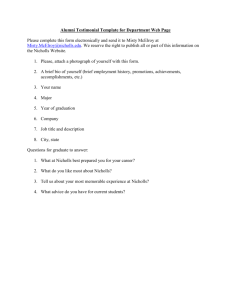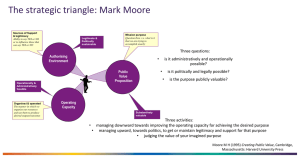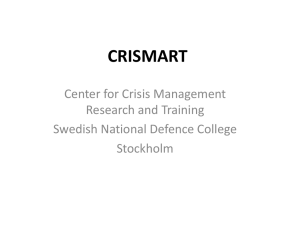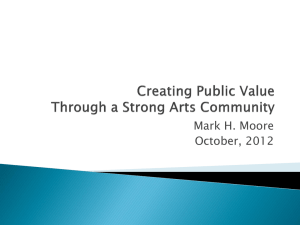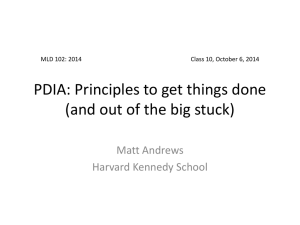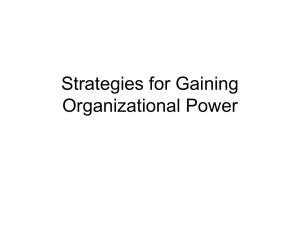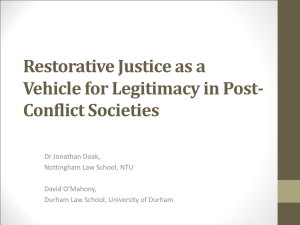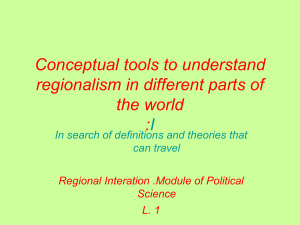Introduction to Social Entrepreneurship
advertisement
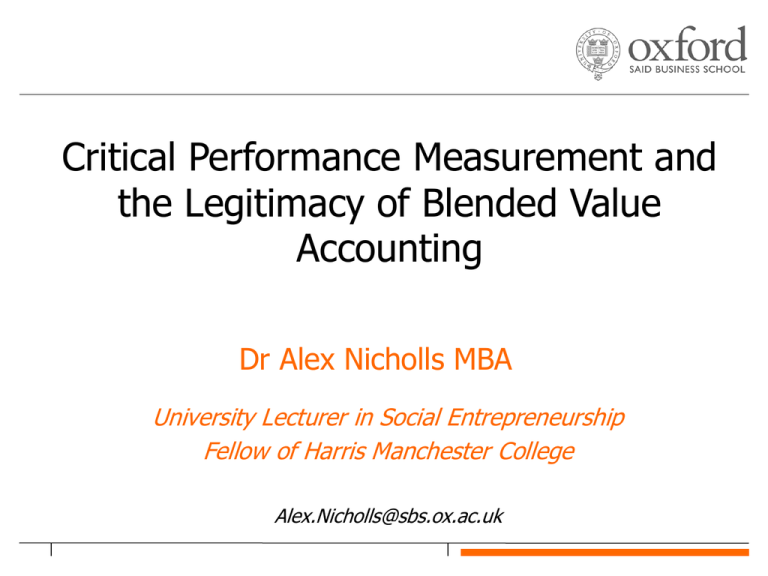
Critical Performance Measurement and the Legitimacy of Blended Value Accounting Dr Alex Nicholls MBA University Lecturer in Social Entrepreneurship Fellow of Harris Manchester College Alex.Nicholls@sbs.ox.ac.uk Critical Framework • What to measure? • Why measure? • Blended Value Accounting • Who measures? • For whom? • How to measure? • Metrics that embody ‘what’, ‘why’ and ‘who’ 2 Critical Framework Epistemology Strategic Purpose Strategic Focus What to Measure? Control Logic Model Why Measure? Planning Mission Objectives Who Measures? Accountability Stakeholders How Can These Different Strategic Foci Be Reconciled? 3 Legitimacy Model • To encompass: • Multiple perspectives • Positivist v interpretive • Multiple values • Which perspectives/values count? • Accounting (‘Audit Society’) v accountability • Who determines this? • What are the consequences? 4 What To Measure? • Materiality • Contingency • Social constructs or positivist ‘realities’? • • • • • 5 Whose reality? Dynamic or set? Referential or absolute? Culturally contingent? Sectorally contingent? What To Measure? • Direct impacts • Process • Outputs • Outcomes • Indirect externalities • Public goods • Unit of analysis? • Individual: pragmatic • Aggregate/common good: cognitive • ‘Other people’: normative 6 What To Measure? • Individual human impacts • • • • Highly personal Multiple variables Complex to measure Timescales unclear • Externalities • Causality • Generating social capital • Bonding/bridging 7 Contingency Framework Ebrahim and Rangan (2010) 8 Logic Model Ebrahim and Rangan (2010) 9 Where Does Impact Lie? Procuring Supplies Fair Trade Employing Workers Designing Product or Service Producing Product or Service Marketing to Target Disenfranchised Groups Delivering Education Green Techniques Microfinance Nicholls (2008) 10 Why Measure? • External accountability • Internal decision making • Assessment of broader social impact Mulgan (2010) 11 Why Measure? • Measure of mission success/failure • Inform future resource allocation • Reward success • Support initial funding proposals • Attract continuing funds • Add credibility to social ventures • Create models and benchmarks • Best practice 12 Theorizing Reporting • Positivist • Reporting data represents empirical reality (Whittington, 1986) • Critical Theorist • Reporting data enacts power mechanisms (Chua, 1986; Power and Laughlin, 1996; see also Lukes, 1974) • Interpretive • Reporting data acts as a symbolic mediator for discussion between organizational practice and stakeholders (Ryan et al, 1992; Gambling et al, 1993) Nicholls (2009) 13 SE Incorporation and Reporting Form of Incorporation Annual Reporting Requirements Social Entrepreneurship Examples Charity Annual report to Charity Commission to Hackney Community include public benefit statement and Transport consolidated financial accounts* Industrial and Provident Society (IPS) Financial accounts to Companies House Baywind Energy Co-op +# Company Limited By Guarantee Financial accounts to Companies House Oxfam + Company Limited By Shares Financial accounts to Companies House Divine Chocolate Ltd + Public Limited Company Financial accounts to Companies House Cafedirect + Unincorporated Voluntary Organization None Oxford Fair Trade Coalition Community Interest Company (CIC) Financial accounts + and CIC34 report on activities to Companies House Develop Your Child *There is some variation depending on turnover: see Table 2 # IPSs can also be charities and would then be required to submit a Trustees’ Report as well as financial accounts + Registered companies can submit unaudited financial accounts if they satisfy two or more of the following: •aggregate turnover must be £5.6 million net (£6.72 million gross) or less; •the aggregate balance sheet total must be £2.8 million net (£3.36 million gross) or less; •the aggregate average number of employees must be 50 or few Nicholls (2009) 14 BVA Spectrum Nicholls (2009) 15 Who Measures (For Whom)? • • • • • • • • Beneficiaries/clients/customers Funders/shareholders Employees Local community Partners Government/regulatory agencies Third parties (civil society/media/competitors) Society at large Perceptions Of Impact Differ For Different Stakeholders 16 Who Is The ‘Customer’? User Purchaser Influencer Clinical services (indigent) Patient Donor Government Elder services Senior Clients’ children Competitors Child Parent Parent Competitors Pharmacy Patient Insurance Regulatory/legal Laboratory services Public Clinic State Government policy Child health 17 Who Measures? The quality of an NGO’s work is primarily determined by the quality of its relationships with its intended beneficiaries Slim (2004) 18 8 Principles Of Accountability • • • • • • • • Inclusivity Comparability Completeness Regularity and evolution Embeddedness Communication Externally verified Continuous improvement Zadek (1998) 19 Effective Accountability • Good measures of mission success/failure • Informs future resource allocation • Reward success • Supports initial funding proposals • Attract continuing funds • Creates models and benchmarks • Best practice • Increases legitimacy of social venture 20 ‘Listen First’ Jacobs and Wilford (2010) 21 How To Measure? GIIRS IRIS Wood and Leighton (2010) 22 Measurement Typology Ebrahim and Rangan (2010) 23 Measurement Typology Ebrahim and Rangan (2010) 24 How To Measure? Mulgan (2010) 25 Young Foundation NHS Tool • Likert Scales + data (if available) • • • • Strategic fit Potential health outcomes Cost savings and economic effects Risks associated with implementation Mulgan (2010) 26 Fair Trade Impacts Nelson (2009) Nelson and Pound (2009) 27 Fair Trade Impacts • • • • • Economic impacts Environmental impacts Empowerment impacts Quality of life and well-being impacts Gender and equity impacts Nelson and Pound (2009) 28 IRIS Framework • ORGANIZATION DESCRIPTION • Indicators that focus on the organization’s mission, operational model, and location • PRODUCT DESCRIPTION • Indicators that describe the organization’s products/services and markets • FINANCIAL PERFORMANCE • Commonly reported financial indicators • OPERATIONAL IMPACT • Indicators that describe the organization’s policies, employees, and environmental performance • PRODUCT IMPACT • Indicators that describe the performance and reach of the organization's products and services • GLOSSARY • Definitions for common terms that are referenced in the indicators 29 GIIRS 30 GIIRS 31 SROI OTS (2007) 32 Organizational Legitimacy A general perception or assumption that the actions of an entity are proper, appropriate, or values and beliefs desirable within a socially constructed set of norms Suchman (1995) 33 Organizational Legitimacy From an institutional perspective, legitimacy is…the means by which organizations obtain and maintain resources…and is the goal behind an organization’s widely observed conformance or isomorphism with the expectations of key stakeholders in the environment Dart (2004) 34 Legitimacy Typology Regulatory Associational Pragmatic Normative Cognitive Legal By association Self interest Expected Worldview Basis of Judgement Compliance with relevant legal requirements and/or international conventions Association with other entities that are already perceived to be legitimate and/or powerful Ability to meet the direct needs and interests of specific stakeholders making the judgement Acting in ways that are consistent with stakeholders’ expectations of how relevant SEs should act Fitting in to conceptual categories that stakeholders habitually use to understand the world around them Antecedents Legally constituted; Mandated by conventions Working relationship with powerful governmental or corporate body; Associated with person of repute or celebrity Effective service delivery; Grounded knowledge to influence policy debate; Providing a channel for exercising charitable values Perceptions of how a SE or a type of SE behave (e.g. effective service delivery to clients, acting with integrity / courage of convictions); Expectations of how a type of SE should behave Pre-existing categories of entity; Concepts that construct social reality; Entities that are part of social fabric, (e.g. BBC & Oxfam in the UK) Strategic Management Registration with regulatory authority Publicised partnerships; Alliance building Understand and meet key stakeholders’ needs; Develop professional expertise Follow socially progressive techniques and procedures; Manage public relations Align with existing categories; Achieve longevity and national respect Nicholls (2010) 35 Critical Legitimacy Framework 36 Epistemology Strategic Purpose Legitimacy Strategic Focus What to Measure? Control Regulatory, Normative Logic Model Why Measure? Planning Pragmatic Mission Objectives Who Measures? Accountability Normative, Cognitive Stakeholders Stakeholder Perceptions Stakeholder Legitimacy Perceptions: Legitimacy Perceptions: Customer/Beneficiary Market-Based Welfare-Based Employee Contractual Trust-Based Government Regulation Public Benefit Competitors Financial Performance Social Performance Investor/Donor Value Creation Cognitive Fit Owner(s) Private Benefit Public Benefit Third Party Actors Organizational Brand Sectoral Brand Positivist/Hard Data Interpretive/Soft Data Nicholls (2010) 37 Performance Legitimacy Performance Legitimacy Impact Metrics Regulatory Data Dashboard Associational Empirical (Hard) Domain Pragmatic Normative Accountability Mechanisms Cognitive Interpretive (Soft) Domain Nicholls (2010) 38 Performance Legitimacy? 39
